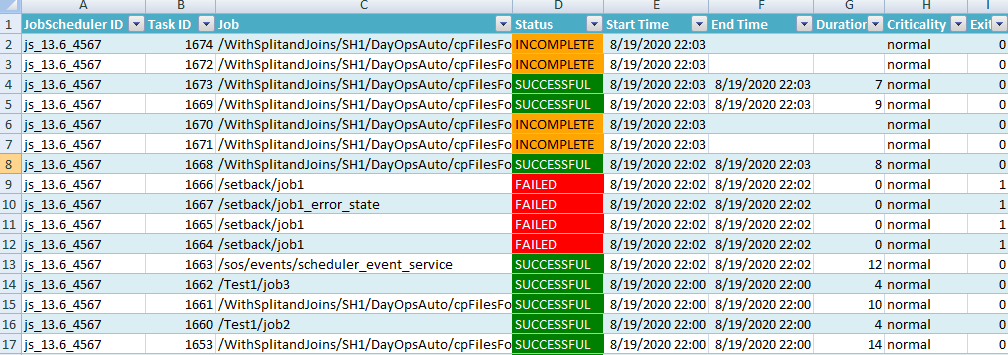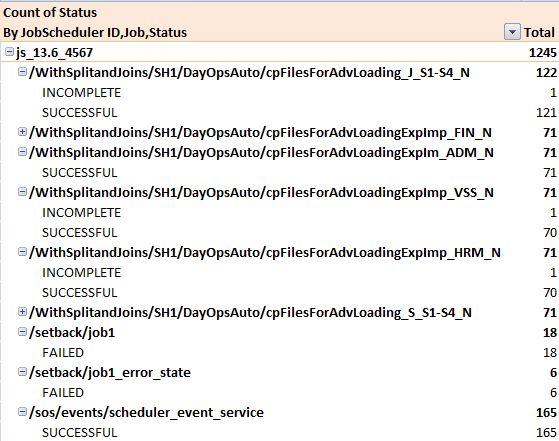Starting Situation
- Instead of having the plain old text in Report files, users can automatically design the Excel reports by using the Import Excel Module.
- Users can organize all the data in rows and columns, with the selective choice of colors, PivotTable, and Charts can design the sheet for better visualization. PowerShell Excel module lets you create Excel pivot tables and charts from the raw data.
Use Cases
The PowerShell CLI is used by jobs to create designer reports. Two modules are applied for this purpose:
- the JobScheduler PowerShell Module
- a reporting PowerShell Module. This example makes use of the ImportExcel PowerShell Module that can be used to create Excel® reports and add PivotTables and PivotCharts in the reports on Windows and Linux.
Find a sample report: jobscheduler_designed_report.xlsx
Please consider that below jobs are examples that have to be adjusted for your environment.
Download: report_design__task_history_windows_job.
Explanation:
- Line 2-3: The job is executed with a Windows Agent that is assigned by a process class. The job is of type "Powershell" and will use the Powershell version provided with the server.
- Line 4-5: The required PowerShell modules are imported. They could be installed with any location in the file system
- Line 7: The Connect-JS cmdlet is used to authenticate with the JOC Cockpit REST Web Service. The required URL and credentials are specified in a PowerShell profile, see PowerShell CLI 1.2 - Use Cases - Credentials Management
- Line 11: Create an object $data and the output of the Get-JSTaskHistory cmdlet in which a number of properties are selected and are specified for the sequence in which they should occur in the report are stored in an object.
- Line 21: The location where Excell will be saved is set to a
$xlfilevariable. - Line 23: Create a variable $WorkSheetName which is used to store the name of the worksheet.
- Line 24-27: creates a spreadsheet, and passes on the Excel Package object which provides the reference to the workbook and turns to the worksheets inside it.
$xlfilestore the path of the file where the Sourcesheet created.- If we are re-writing an existing sheet, and the new data doesn’t completely cover the old, we may be left with “ghost” data. To ensure this doesn’t happen, we can use the
-ClearSheetoption to remove old data. -PassThrureturns the PivotTable so it can be customized.-AutoSizeparameter allows us to resizes the columns of the spreadsheet to fit the data that is in it and to get the column-widths right- For adding the color to the conditional text
-ConditionalTextis used. There are more types of conditional format are supported. Here we use conditional text for the job status color like (successful=green, Incomplete=range, Failed=Red) For assigning the name to the worksheet
-WorksheetNameparameter is used. The default name of the worksheet is sheet1.- The -
IncludePivotTableand -IncludePivotChartcmdlets generate the pivot table and chart. the parameter -ChartTypelets you pick what type of chart you want, there are many to choose from Examples: Area, Line, Pie, ColumnClustered, ColumnStacked100, ColumnClustered3D, ColumnStacked1003D, BarClustered, BarOfPie, Doughnut, etc. - The -
PivotRowsand-PivotDataparameters describe how to tabulate the data.
- Line 30:
PivotTableNameparameter is used as the Name for the new PivotTable. - Line 31: By default, a PivotTable will be created on its own sheet, but it can be created on an existing sheet. In the above job example
$excel.$WorkSheetName.cells["K1"]parameter defines the cell place in the existing worksheet, where the pivot table will be created. - Line 32:
$excel.$WorkSheetNamerefers to the Worksheet where the source data is found. - Line 33: PivotRows parameter is used for Fields to set as rows in the PivotTable.
- Line 34: PivotData parameter contains a hash table in form "FieldName"="Function," where a function is one of Average, Count, CountNums, Max, Min, Product, None, StdDev, StdDevP, Sum, Var, VarP.
- Line 35: For applying a table style to the PivotTable
PivotTableStyleparameter is used. The PivotTableStyle “Medium6” is the default table style but there are plenty of others to choose from. Example: PivotTableStyles = None, Custom, Light1 to Light21, Medium1 to Medium28, Dark1 to Dark11".
Sample Report Sheet with colorful status:
The below screenshot contains the output of the Get-JSTaskHistory stored in the Excel sheet report. Users can change the colors of text and background of cells according to their choice. The below example represents the status of Jobs with different colors using
-ConditionalTextparameter of the Import Excel module.
Sample Charts:
- There is a sample PivotChart created by the use of parameter -ChartType ColumnClustered3D. The ColumnClustered3D ChartType is used here to show the number of status (successful, Incomplete, Failed, Planned) of Jobs.
Sample PivotTable:
- The sample PivotTable shows the RowHeaderCaption as "By JobScheduler ID, Job, Status" which is also present in PivotTable to represent the status of Jobs according to JobScheduler ID. You can adjust the style of the table by the parameter
PivotTableStyle. Users can also change the view like expand and collapse the view of the table.


